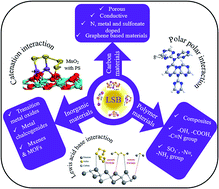Recent advances in separators to mitigate technical challenges associated with re-chargeable lithium sulfur batteries
Abstract
Lithium sulfur battery (LSB) research has received considerable attention due to the high theoretical gravimetric energy density of LSBs. However, in practice, the active sulfur material needs to be coupled with a conducting material due to its poor electronic conductivity (5 × 10−30 S cm−1) – reducing the battery energy density. Furthermore, lithium polysulfides (PSs), formed as soluble intermediate phases, can shuttle between the cathode and the anode – leading to rapid capacity degradation. Coating the traditional separators is one way to mitigate the shuttle effect which requires proper understanding of the nature of PSs to design effective separator coating materials. In this review, the technical limitations of LSBs are introduced with detailed information about the PS dimensions. Subsequently, carbon, polymer and inorganic coating materials have been highlighted with their significant contributions to the performance of LSBs. A particular focus has been placed on their mechanisms of trapping PSs through polar–polar, Lewis acid–base interactions and physical confinement. Finally, the key factors which influence the performances of LSBs are summarized.

- This article is part of the themed collection: Recent Review Articles


 Please wait while we load your content...
Please wait while we load your content...